Search and rescue dog
Search and rescue dogs are valuable after natural disasters and mass-casualty incidents, and for locating missing people. Dedicated handlers and well-trained dogs are required. Search and rescue dogs are typically worked by a small team on foot.
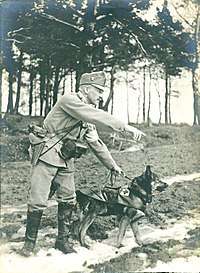
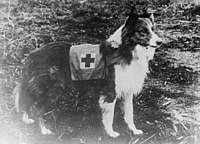
Search and rescue dogs detect human scent. Although the exact processes are still researched, it may include skin rafts (scent-carrying skin cells that drop off living humans at a rate of about 40,000 cells per minute),[1] evaporated perspiration, respiratory gases, or decomposition gases released by bacterial action on human skin or tissues.
Types

.jpg)
From their training and experience, search and rescue dogs can be classified broadly as either air-scenting dogs or trailing (and tracking) dogs. They also can be classified according to whether they scent discriminate, and under what conditions they can work. Scent discriminating dogs have proven their ability to alert only on the scent of an individual person, after being given a sample of that person's scent. Non-scent discriminating dogs alert on or follow any scent of a given type, such as any human scent or any cadaver scent. SAR dogs can be trained specifically for rubble searches, for water searches, and for avalanche searches.
Air-scenting dogs use general human scents to home in on subjects, whereas trailing dogs rely on scent of the specific subject. Air-scenting dogs typically work off-lead, are usually, though not always, non-scent-discriminating (e.g., locate scent from any human as opposed to a specific person), and cover large areas of terrain. These dogs are trained to follow diffused or wind-borne scent working perpendicular to the wind, then to indicate their find (for example, by sitting with the lost party and barking until the handler arrives, or by returning to the handler and indicating contact with the subject, and then lead the handler back to the subject). Handler technique, terrain, environment (vegetation), and atmospheric conditions (wind speed and direction, temperature, humidity, and sky conditions) determine the area covered by air-scenting dogs, although a typical search area may be 40–160 acres and scent sources can be detected from a distance of 1/4 mile or more. Although other breeds can be trained for air-scenting, the prototypical air-scenting dog is a herding (e.g., German or Belgian Shepherd Dogs, Border Collies) or sporting (e.g., Tollers, Golden, Labradors or Springer Spaniels) breed that has a reputation for working closely and in coordination with a human handler.
Tracking
Tracking dogs will typically work on lead and will mostly have their nose to the track following ground disturbance. A good tracking dog will be able to work through a variety of terrain as well as successfully maneuver turns and "double backs" that a subject might take.
Trailing
A trailing dog is scent specific, can also have his/her head up using some of the air scent techniques to find the subject. Trailing dogs will work on lead, and trailing dogs will venture off the actual path that a subject took should a scent pool be discovered. This is not to be considered an error by the dog, as they are following a specific scent and working through all other human scents to get to the source. It is a common misconception that only German Shepherd Dogs, Doberman Pinschers and Bloodhounds do this type of work.
All dogs are capable of tracking and trailing; larger, sport, hound, working and herding breeds tend to be used more often simply for their adaptability in various terrain.
Variations
In addition to these types of dogs, some teams cross train dogs in both trailing and airscenting and use them as scent specific "area searches". Typically these dogs are worked in an area that an airspace dog would work, but are capable of ignoring other search teams and other people in or near the assigned search area. When deployed this way, these airscenting dogs require a scent article as does a trailing dog. These dogs train every day and are very hard workers.
Applications
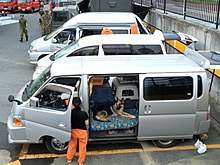
Specific applications for SAR dogs include wilderness, disaster, cadaver, avalanche, and drowning search and rescue or recovery.
In wilderness SAR applications, dogs can be deployed to high-probability areas (places where the subject may be or where the subject's scent may collect, such as in drainages in the early morning) whereas tracking/trailing dogs can be deployed from the subject's last known point (LKP) or the site of a discovered clue. Handlers must be capable of bush navigation, wilderness survival techniques, and be self-sufficient. The dogs must be capable of working for 4–8 hours without distraction (e.g., by wildlife).
Disaster dogs are used to locate victims of catastrophic or mass-casualty events (e.g., earthquakes, landslides, building collapses, aviation incidents). Many disaster dogs in the US are trained to meet the Federal Emergency Management Agency K9 standards for domestic or international deployment; advanced agility and off-lead training are prerequisites reflecting the nature of these dogs' application. Disaster dogs rely primarily on airspace, and may be limited in mass-casualty events by their inability to differentiate between survivors and recently deceased victims.
Human remains detection
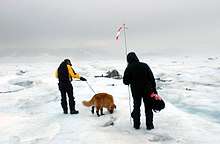
Human remains detection (HRD) or cadaver dogs are used to locate the remains of deceased victims. Dogs might work off-lead to search a large area, or on-lead to recover clues from a crime scene. Tracking/trailing dogs are often cross-trained as cadaver dogs, although the scent the dog detects is clearly of a different nature than that detected for live or recently deceased subjects. Cadaver dogs are able to locate buried, submerged and concealed bodies, decomposed bodies, body fragments (including blood, tissue, hair, and bone), and scattered human remains dispersed by animal scavenging.[2]
In the winter of 1997 through to the spring of 1998 Dr. Deb Komar of the University of Alberta, Canada conducted a study 'The use of cadaver dogs in cases of advanced decomposition: A field study in adverse recovery scenarios and animal vs human scent discrimination'. Dr. Komar worked with cadaver dog teams from the RCMP Civilian Search Dog Program now the Canadian Search Dog Association [3] and the Search and Rescue Dog Association of Alberta.[4] This study showed the accuracy rates of cadaver dogs in moderate to adverse winter weather conditions, and also the dogs' capabilities to discriminate between animal and human remains. It indicated that an accuracy rate near 100% can be achieved through careful and directed training. Her work has been published in the Journal of Forensic Anthropology. Of key importance were the materials used in training as the artificial scents available proved significantly different as compared to biological tissue containing bacteria, etc.[2]
In Croatia dogs have been used to find almost 3,000 year old burial sites.[5]
Avalanche dogs
Avalanche dogs work similarly to airscenting, disaster, or cadaver dogs, and must be able to rapidly transition from a wilderness SAR-airscenting scenario to a disaster scenario focused on pinpointing the subject's location. An Avalanche dog's main responsibility is usually to find humans that are trapped under snow. Some avalanche dogs can smell people that are under 15 feet of snow. Some dogs that are used for this job are St. Bernards, German Shepherd Dogs, and Labrador Retrievers.[6]
Training
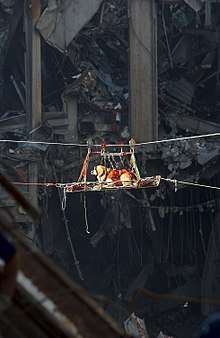
Training is a rigorous, time-consuming and comprehensive process for both the dog and the handler. For the dog, training is best begun early in life (upon acquisition of a suitable puppy, 8–10 weeks) for deployment of the dog in 12–18 months and retirement at 5–10 years, depending on the breed and individual dog. Obedience training is essential for the dog's safety, order at staging areas, and to maintain professionalism in law enforcement and the public audience. Socialization and handler-canine bonding are especially important for airscenting dogs. Basic agility training is necessary, and advanced training may pay off unexpectedly. Scent training should be initiated early and is often best accomplished by working with an experienced, well-established local training group that has a track record of working with local or state law enforcement.
For puppies, expect to train obedience, socialization, and agility daily 2-5 times for 10 up to 60 minutes, and scent training 3-7 times per week for 5–30 minutes. As the dog's abilities improve, daily obedience training continues, with impromptu or planned agility and socialization sessions. Scent training frequency decreases (3-5 times/week) but duration increases (20–60 minutes per session). Search-ready dogs need once-weekly training sessions (4–8 hours) along with frequent focus sessions (5–60 minutes, 3 or more times per week). Training outside the dog's primary focus (e.g., teaching a dog scent discrimination, cadaver, or avalanche techniques) should be done cautiously and only once the dog reliably performs in his primary training area.
Usually training starts as a game played with puppies,[7] starting with simple reward-based training (i.e. puppy is given a treat or allowed to play with a toy upon showing a simple skill such as retrieving the toy and bringing it back to the trainer) and expanding outward to "games" with more specific job skills (i.e. a well-loved toy is scented with the desired scent to find; when puppy finds the toy, he/she is allowed to play with the toy; later, scent and toy are separated so that puppy will search for the scent and is rewarded with the toy afterward).
The "games" technique is particularly effective with dogs bred for retrieval (such as hunting and sporting breeds) but has also been successful with working and herding dog breeds. A more commonly used approach is to base training on herding, prey/pursuit, and pack instincts: initial training for puppies usually involves run-away games where the handler runs from the puppy and hides a short distance away. Basic instincts drive the puppy to locate the subject, initially by sight but with the association of human scent. To advance this training, the subject hides further away or longer times pass between departure of the subject and release of the dog. The dog is forced to rely increasingly on scent to locate the subject. Eventually, the dog can be transitioned to search without seeing the subject depart by simply giving the command used when he's released during basic runaway training. During all stages, finding the subject is reinforced by multiple means (praise, play, or food treats).
For the handler (again, based on wilderness scenting experience), wilderness orienteering and wilderness self-sufficiency/survival are essential training skills. Dog handling skills must also be learned during training (e.g., recognizing working v. distracted behaviors, differentiating between alerts and finds, and positioning the dog to maximize terrain coverage). Of primary importance is the handler's ability to understand how the dog is working at any point in time, for which the handler will require detailed and intimate understanding of scent theory. Advanced emergency medical skills are usually not required but are advisable. There are rigorous studies of scent theory, lost person behavior, canine search technique, and incident command in hard-to-find publications by William (Bill) Syrotuck. Due to the level of physical exertion required at times, the top end CHAR organizations may require difficult physical standardized testing. This ensures that the handler is able to cope with the ever-changing situations presented to them.
Scenting dogs are trained to find (i.e., follow human scent to its source, be it human or traces of a human), but this basic process has been elaborated and improved upon: dogs now are commonly also trained in recall/refit and indication. The entire process may begin with the command "Go find!", indicating that the dog is to search until the find is made. After the find, the dog can be trained to return to the handler (recall), perform a trained indication (often a bark coupled with some form of meaningful touching of the handler, such as a paw placed on the handler's leg or a "sit-stay" at the handler's feet), and return to the subject (refine, sometimes cued with the "Show me!" command). Once the handler is with the subject, the dog is released (and during training, rewarded). Dogs are trained in the recall/refine shuttle between the handler and the source until the handler and subject are within sight (this builds on the dog's natural pack instinct). This is of greatest use in situations where the dog may be ranging from the handler (wilderness scenting) or the subject may be concealed or out of sight (e.g., at night, hidden in brush), but is less useful for dogs trained for close-quarters searches (e.g., cadaver and drowning dogs).
There are two schools of thought on recognizing when the dog has made a find, the "natural" or untrained indication, versus the trained indication. With the natural indication, the handler must learn to recognize the dog's change in body language when s/he has made a find. For example, the dog may approach the handler and give specific look, or return to the handler in a very determined manner; each dog's natural indication is unique and often difficult for the handler to accurately describe to others. This method is touted as being accurate (currently only method used by RCMP), instinctual, and natural thus requiring less training for the dog and more for the handler. This allows the dog to "Have a bad day" and given that it is still a natural reaction the dog will still react in the same way.
During training, the handler must learn to recognize this behavior without cueing the dog (if not the dog may learn to "indicate" only when the handler subconsciously prompts him to, a common mistake during the training process). Early training sessions may get complicated if the handler (who is learning to read the dog) fails to reward a successful find appropriately because she failed to recognize the dog's natural indication. Thus it is important to train with those having more experience. On scene, the handler must pay constant close attention to the dog, which may be difficult or dangerous in commonly encountered search scenarios (e.g., night, hazardous terrain, low-visibility, while navigating off-trail, when fatigued or distracted). Handlers using dogs trained to a natural indication risk missing finds outside of training scenarios, mistaking alerts for finds, or missing finds because a natural indication was not noticed or recognized, however they have the advantage in that as the dog tires or becomes distracted they will still exercise the natural behavior while they may not follow up with the trained response.
The trained indication involves an additional step in the search-find process; the dog is taught to perform a clearly recognizable behavior only upon finding the subject. For example, the dog may return to the handler and sit, perform a jump up, bark (either at the handler or near the subject), or grab a decoy or bringsel. Addition of this extra step during training is easily accomplished, has the benefit of being easily recognizable under any circumstance, and can be easily differentiated from an alert (see below). Often, training the dog to perform a specific behavior is easier and more reliable than training handlers to consistently and reliably read a dog's "natural" indication. This takes less training on the part of the handler and more on the part of the dog. An example of a trained response is that, when a distant find has been made, the dog can be taught to repeatedly shuttle between the subject and handler using a refind-return-indicate-refund sequence.
When using a trained indication, the behavior must be well-ingrained in the search-find-recall process that a fatigued dog does not skip it. Distractions are still a problem and extensive training must be done to avoid this lest something as simple as a loud noise or animal prevent the lost person from being found. Advanced dogs can be trained to give different indications depending upon the nature of the find: for example, a jump-up for a live air scent find and a sit for cadaver. A potential problem with this method is that poorly trained dogs (or those who have been rushed through training) can become distracted before performing the alert.
An alert by an scenting dog can be distinct from an indication (although for a dog that uses a natural indication, the two may not be distinguishable). Both involve being able to read the dog's behavior. Alerts are instances where an scenting dog detects human scent but has not located the subject or source. Alerts can be recognized by a change in the dog's behavior—pointing, following a scent upwind, circling, or following scent up terrain or obstructions, for example. Recognizing an alert is important for any experienced handler, as the location of alerts along with wind conditions, environmental conditions, and terrain can be used by the handler to alter the search strategy. Regardless of whether the dog is trained to perform an indication on find, or whether the handler uses a natural indication on find, all handlers must be able to recognize an alert in order to effectively deploy their dog. Inexperienced handlers who use trained indications may have difficulty recognizing alerts, while handlers who rely on a natural indication may not be able to differentiate an alert from an indication (since the behaviors are essentially the same).
Organizations
Numerous countries, cities and regions have search and rescue organizations using dog-and-handler teams that can be mobilized in an emergency or disaster. Here are a few organizations.
- International Rescue Dog Organisation (IRO) is the worldwide umbrella organisation for training and testing of search and rescue dog work. IRO partners with International Search and Rescue Advisory Group and United Nations for coordinating disaster relief missions worldwide.[8]
- FEMA Urban Search and Rescue Task Force, US teams of dogs and handlers which are deployed to emergency and disaster sites within hours.
- Emergency Response Team Search and Rescue respond to emergencies and disasters in United Kingdom and Canada.
- Special Tasks and Rescue Dog Operations Unit supports the South Australia Police with tracking, searching, and finding lost persons.
Notable dogs
- Beauty, a wired haired terrier, was a search and rescue dog during the Second World War in England.
- Jake, a Labrador Retriever, was a search and rescue dog that worked the disasters of September 11 attacks (2001) and Hurricane Katrina (2005).
- Orion, a Rotweiller, helped save the lives of at least 37 people in 1999 from drowning during flash floods in Vargas, Venezuela.[9]
- Rex, entered burning buildings to find trapped people during the Second World War in England.
Dog breeds with a breed history of being search and rescue dogs includes the Alpine Spaniel (extinct) and the St. Bernard.
See also
- Nosework
- Working dog – Dog used for work
- Search and rescue horse
References
- Ohio Valley Search and Rescue.Inc. Glossary
- Komar, D. (March 9, 1999). "The use of cadaver dogs in locating scattered, scavenged human remains: preliminary field test results". Journal of Forensic Sciences. 44 (2): 405–408. PMID 10097372 – via PubMed.
- Canadian Search Dog Association
- Search and Rescue Dog Association of Alberta
- Dogs show a nose for archaeology by sniffing out 3,000 year old tombs The Guardian, 2019
- "What Dog Breeds Make the Best Search and Rescue Dogs?". Animal Den. Retrieved 28 March 2014.
- Canadian Search Dogs
- "Strong Partners". International Rescue Dog Organisation.
- "Orión, el perro rescatista en la tragedia de Vargas (Orion, the rescue dog in the Vargas tragedy)" (in Spanish). December 11, 2014. Archived from the original on December 16, 2014.
External links
| Wikimedia Commons has media related to Search and rescue dogs. |
.jpg)